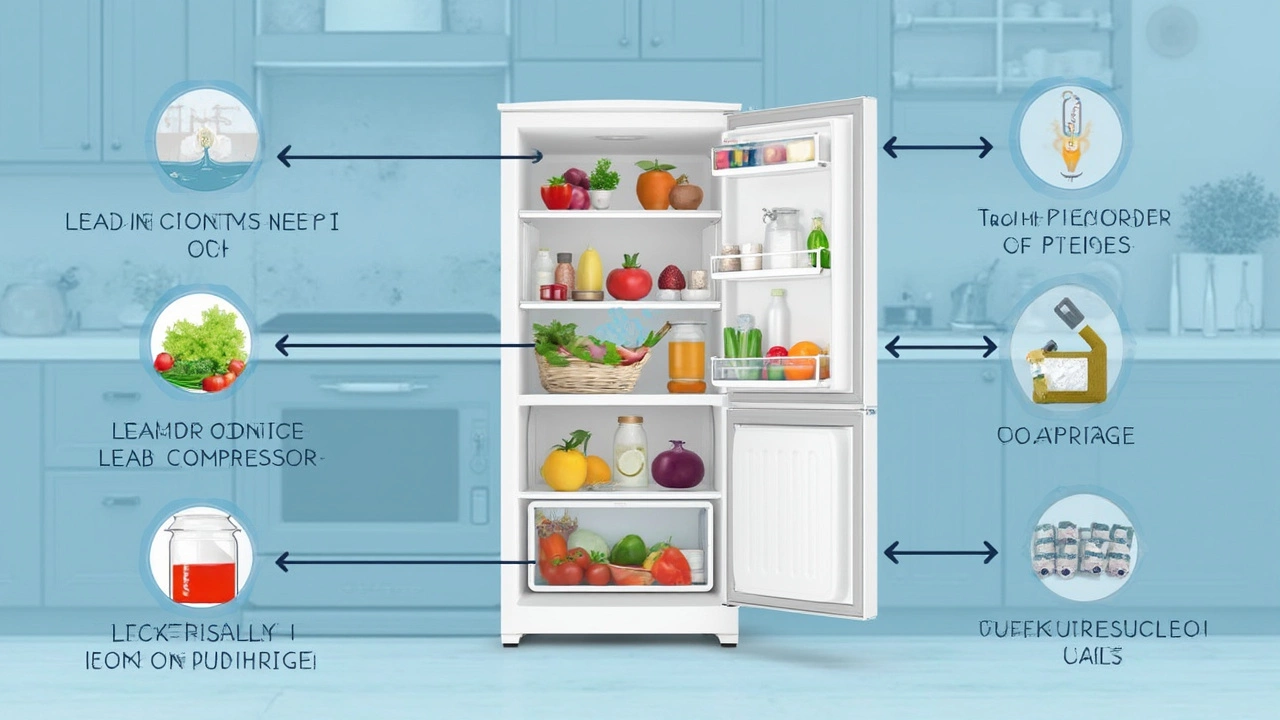You open your fridge, grab the milk, and something smells… off. If this happens a lot, you might be dealing with a fridge that's heading for trouble—long before it quits completely. No need to panic, but ignoring the signs can wreck your groceries and even your budget.
Most fridges don't die overnight. They drop hints first: the motor sounds different, it's not as cold as it used to be, or leftovers turn funky days ahead of schedule. Catch these red flags early, and you might save yourself an emergency food rescue mission or a wallet-busting repair bill.
Want to know if your fridge is on the verge of retirement? Look for unusual warmth inside, pools of water near or inside the unit, and a compressor that's running non-stop. Even minor things—like ice cream that never gets hard or veggies that freeze—are often early warnings you shouldn't ignore.
- Not-So-Obvious Signs Your Fridge Is Failing
- Weird Noises and What They Mean
- When Food Goes Bad Way Too Fast
- DIY Checks Before Calling a Pro
- Knowing When to Repair or Replace
Not-So-Obvious Signs Your Fridge Is Failing
Most people wait until their fridge stops working completely before acting, but the biggest problems actually start with small, easy-to-miss clues. A healthy refrigerator should keep your food safe, run quietly, and have even cooling. When things get a little off, that’s when to pay close attention.
One sneaky sign is sweating or condensation on the outside or inside walls. If you feel the outside of your fridge getting warmer than usual, or you notice droplets building up, that’s a warning. Sometimes, seals around the door stop doing their job, letting warm air in and cold air out. This forces your fridge to work way harder, making things worse over time.
Another hint is fluctuating temperatures. Maybe you set the fridge to 37°F, but a thermometer you leave inside tells you it jumps to 42°F every now and then. If you notice dairy going sour quickly or frozen items with soft spots, trust your senses—something’s up beyond normal wear and tear.
- Doors not sealing properly – test with a dollar bill; if it slides out easily, the gasket might be shot.
- Random puddles under or inside the fridge – not always from a spilled drink; leaking coolant or blocked defrost drains could be to blame.
- Lining or shelves cracking – small plastic splits can signal temperature swings inside.
- Sticky or jammed freezer drawers – ice buildup or humidity means the defrost cycle might not be working right.
What’s wild is how food safety can drop fast when your fridge is off by just a few degrees. Check out this handy breakdown:
| Temperature (°F) | Safe Storage Time for Leftovers |
|---|---|
| 33-39 | 3-4 days |
| 40-44 | 1-2 days |
| 45+ | Less than a day |
Some energy bills creeping up? Older refrigerator models losing efficiency drive up your power use. If you notice costs rising with no explanation, your fridge could be the culprit, quietly sucking more juice as it struggles to keep cool.
Weird Noises and What They Mean
It’s totally normal for fridges to make some noise—a low hum, a quiet buzz when it’s running, or a little click when the compressor kicks in. But when sounds start getting louder, longer, or just plain odd, your refrigerator might be telling you something’s wrong.
Here’s a breakdown of common fridge noises and what could be causing them:
- Loud buzzing or humming: Often means the compressor or condenser fan is working harder than it should. This could be a dirty coil or even a failing compressor.
- Rattling or vibrating: Sometimes it’s just the fridge not sitting level—easy to fix by adjusting the legs. But if the noise is coming from inside, check the condenser fan. Loose items on top or inside the fridge can also vibrate and make odd sounds.
- Clicking or popping: Some clicks are normal, especially right after the compressor shuts off. Regular, loud, or rapid clicking may mean an issue with the start relay. If it comes with cooling problems, that’s a red flag.
- Squealing or chirping: Usually the evaporator fan motor. If it gets loud, the motor might be about to fail. That fan runs when the fridge door is closed, so you may not always hear it during the day.
- Hissing or dripping: This is often water from the defrost cycle hitting the hot defrost heater. Slight hissing is ok, but if it’s constant or extra loud—and there’s water pooling—something might be up with the defrost system.
Want to know which sounds matter most? Here’s a quick guide for what’s normal—and what’s not:
| Noise | Possible Cause | Should You Worry? |
|---|---|---|
| Low hum | Normal running | No |
| Loud, constant buzzing | Dirty coils, overworked compressor | Yes |
| Sharp clicking | Faulty start relay or compressor | Yes |
| Occasional pop | Thermal expansion, defrost cycle | No |
| Screeching, chirping | Bad fan motor | Yes |
Quick tip: If the weird sound is new and you can’t find an obvious reason (like an unbalanced fridge or something rattling on a shelf), unplug the fridge for a few minutes and plug it back in. If the noise keeps coming back, it’s smart to call in a repair tech before things get worse—and more expensive.

When Food Goes Bad Way Too Fast
If you’re tossing out milk before its expiration date or seeing slimy veggies two days after a big shop, you’re not just unlucky. It’s a classic warning sign your refrigerator isn’t keeping things cold enough. According to the FDA, your fridge should always stay at or below 40°F (4°C). Even just a couple of degrees warmer, and bacteria throw a party.
Most folks spot these problems after a few ruined meals, but sometimes the issue sneaks up slowly. If you’re noticing your leftovers spoiling way quicker than you remember, don’t just blame your cooking. Check to see:
- Is dairy (especially milk) souring days early?
- Is raw meat or deli meat looking gray or getting that gross smell almost right away?
- Do fruits and veggies wilt, mold, or turn mushy before the week’s out?
These are all the food’s way of yelling, “Help! It’s not cold in here.”
Here’s a handy cheat sheet so you know how long foods usually last in a properly working fridge:
| Food Item | Normal Shelf Life (Days) |
|---|---|
| Milk | 5-7 |
| Raw chicken | 1-2 |
| Cooked leftovers | 3-4 |
| Berries | 3-5 |
| Leafy greens | 5-7 |
If these numbers seem like a fantasy when compared to your reality, grab a cheap thermometer from the drugstore. Check the inside of the fridge (middle shelf, tucked in the back). Anything above 40°F (4°C)? Time to act.
Sometimes, fast spoilage is due to simple stuff like a door not closing all the way or someone cramming hot leftovers in. But if you’ve ruled out the basics and your food’s still going bad too fast, your fridge could need a fix or, worse, a replacement.
DIY Checks Before Calling a Pro
Here’s the thing—no need to shell out cash for a repair tech before giving your fridge a good check yourself. You’d be surprised how often the fix is something simple.
- Refrigerator settings: Double-check the temperature dials. The fridge should stay between 37–40°F (3–4°C), and the freezer at 0°F (-18°C). Turning the dial by accident happens more than you think, especially if you’re shoving groceries in while distracted.
- Door seals: Open the door and slip a piece of paper (or a dollar bill) in the seal. Close it. If you can pull the paper out with zero resistance, your seals are shot and cold air is leaking. Dirty seals? Wipe them down and see if they grip better.
- Blocked vents: If the back of your fridge or freezer is jam-packed, move stuff away from vents. Crowded airways mess with cooling, and that’s a really common cause of uneven temps inside.
- Clean the coils: Find those dust-covered coils at the back or under the fridge. Unplug the fridge, grab a vacuum, and suck up the dust. Dirty coils make your fridge work overtime and could shorten its life.
- Check for power issues: Is the fridge plugged in all the way? Has a breaker tripped? Don’t laugh—a loose plug really can be the fix, and it happens a lot.
Want to know how these DIY fixes stack up? Check out this quick table of common issues—and how often regular folks solve them without a pro:
| DIY Check | Problem Fixed (%) |
|---|---|
| Set temp controls | 31% |
| Seal cleaning/replacement | 24% |
| Cleared vents/unblocked airflow | 18% |
| Coil cleaning | 15% |
| Simple power issues | 12% |
If your food still spoils fast or things just don’t feel right after all these checks, that’s when you want a pro. But a lot of the time, these easy steps do the trick.

Knowing When to Repair or Replace
So your fridge is acting up. Should you shell out for a repair, or is it time to say goodbye for good? This isn’t a one-size-fits-all answer, but there are some easy rules of thumb.
If your refrigerator is less than eight years old, repairs usually make sense—especially if it’s a high-end model or a built-in. For older, basic fridges, you’ll probably end up saving money in the long run by replacing it. Energy bills add up, and older fridges tend to be less efficient.
- Frequent breakdowns? If your fridge has needed two or more repairs in the last year, it’s a red flag.
- Compressor failure? Replacing a compressor can cost almost half the price of a new fridge.
- Struggling with cooling? When your fridge can’t keep food cold even after you clean the coils and seal the door, that’s a big sign it’s on its way out.
Keep in mind, newer models use up to 40% less energy than fridges made just 15 years ago. That adds up, especially with power bills climbing. Here’s a quick breakdown of typical fridge lifespans and costs:
| Fridge Type | Average Lifespan (years) | Estimated Repair Cost ($) | Replacement Cost Range ($) |
|---|---|---|---|
| Top Freezer | 10-13 | 160-350 | 500-1,200 |
| Bottom Freezer | 10-15 | 200-400 | 800-2,000 |
| French Door | 9-13 | 250-600 | 1,400-3,000+ |
| Side by Side | 8-12 | 200-500 | 1,000-2,500 |
One more tip: Check your warranty and any credit card extended coverage before booking a repair. Sometimes you’re already covered and don’t even know it.
If you hear yourself saying, “It’s old, it’s noisy, and my food keeps spoiling,” it might be time to bite the bullet. Still on the fence? Take that as your cue to weigh energy use, repair costs, and how much hassle you’re willing to put up with. Sometimes peace of mind is worth the investment in a new refrigerator.
